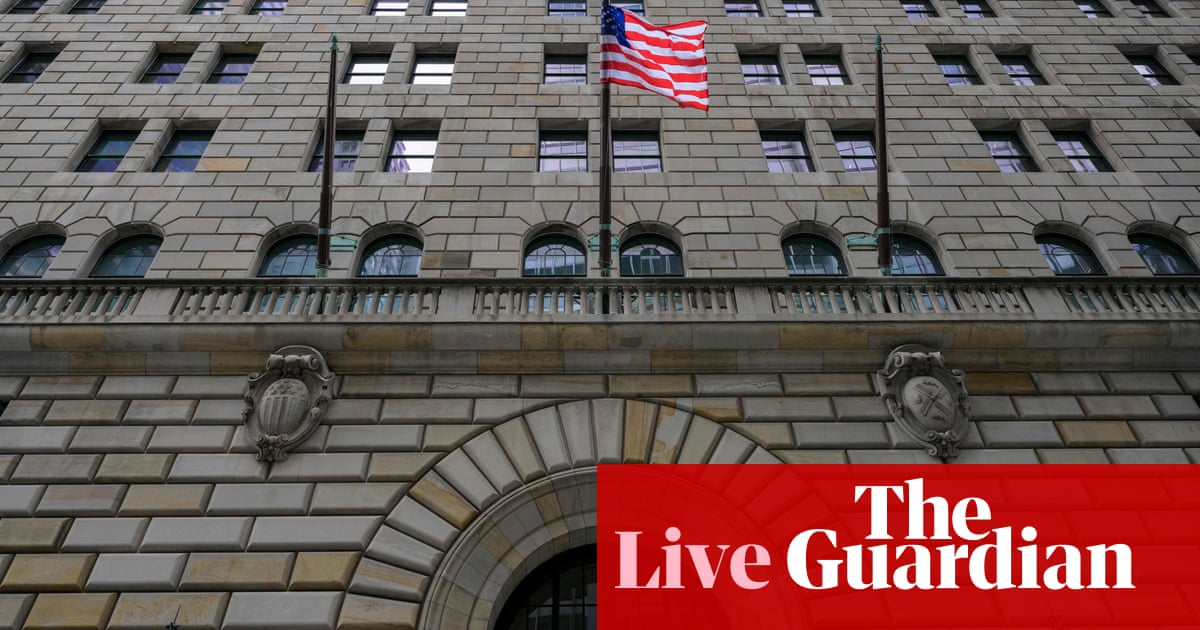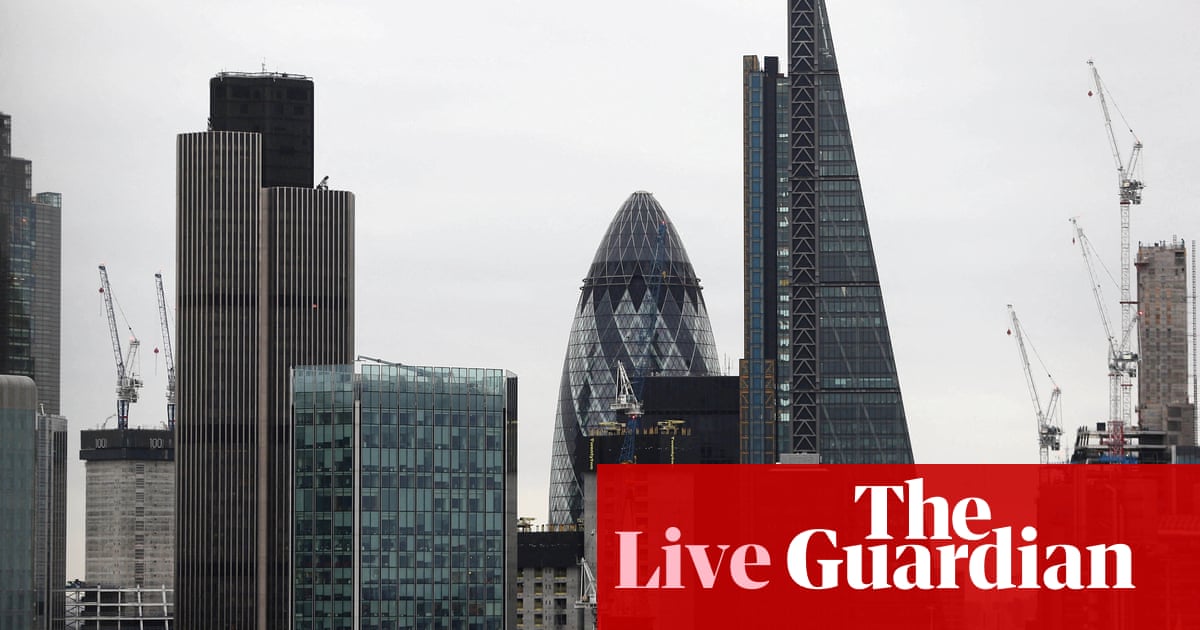
Lagarde: "premature to discuss rate cuts"
The Q&A has started. The first question is whether the governing council discussed a rate cut at today’s meeting.
Lagarde said:
The consensus around the table of the Governing Council was that it was premature to discuss rate cuts.
One other thing, which was very much a consensus around the table was that we had to continue to be data dependent.
Closing summary
European Central Bank president Christine Lagarde has said that policymakers agreed at today’s meeting that talk of interest rate cuts is “premature”. Last week, she told Bloomberg in Davos that the bank could start cutting rates in the summer.
The pace of US economic growth slowed in the last three months of 2023, but far less than had been expected, underlining the continued resilience of the economy. Growth slowed to an annualised rate of 3.3% from 4.9% in the third quarter. The economy grew by 2.5% in 2023, its best performance since 2021.
Lloyds Banking Group is cutting around 1,600 jobs across its branch network as it shifts more services online to save money.
It will also create around 830 jobs elsewhere in the bank.
Britain’s next government faces some of the toughest tax and spending choices for generations as it will be forced to grapple with the impact of weak growth and high debt interest payments, a leading thinktank has said.
The Institute for Fiscal Studies (IFS) warned that Jeremy Hunt’s much-predicted budget tax cuts risked being reversed or paid for by spending cuts, and urged the Conservative and Labour parties to “level” with voters before polling day.
Thank you for reading. We’ll be back tomorrow. Bye! – JK
Bank of England, Treasury press ahead with "digital pound"
The government and the Bank of England will press ahead with the design of a digital pound without pledging that a “Britcoin” will become available to the British public.
Officials at the Bank and the Treasury said a consultation exercise last year showed there was an appetite for a new method of transferring money electronically.
Responding to concerns that the Bank and the government would have access to users’ personal data, officials said primary legislation would safeguard digital currency users in the same way bank accounts are protected at the moment.
The Treasury said it would also maintain cash in circulation after a strong backlash from among the 50,000 respondents to the consultation, including MPs, who feared paper banknotes and coins would be phased out.
More than 40 countries are understood to be pursuing the development of a digital currency that is expected to rival the crypto currencies Bitcoin and Ethereum, which are valued on independent exchanges.
Supporters of the scheme, which could be launched before the end of the decade with the Bank acting as the backstop or custodian of the new digital currency, said it will allow innovation in the UK financial services sector, keeping firms in financial centres across the UK at the forefront of a global market place.
Critics, including members of the House of Lords economic affairs committee, have said they have “yet to hear a convincing case” for why the UK needs a central bank digital currency (CBDC), while some MPs asked whether the plan is “a solution in search of a problem”.
Simon Youel, head of policy and advocacy at research and campaign group Positive Money, said the government needed to respond to the rise of private crypto currencies.
The huge response to the consultation highlights the importance of a genuinely inclusive national conversation on the future of our money, which is presently facing a rapid privatisation as cash gets replaced by electronic bank money.
Colin Finlayson, fixed income investment manager at Aegon Asset Management, says the ECB may have to start cutting rates earlier than the summer.
The ECB kept policy unchanged at 4%, as widely expected. Although Ms Lagarde attempted to push back on the current market expectations of rate-cuts in the coming month, she did have to concede that both underlying inflation and inflation expectations have continued to fall.
With the ECB current growth outlook characterised as having risks to the downside, the market paid little attention to her attempts to dampen rate-cut enthusiasm. The ECB are guiding towards the summer at the earliest for any rate cuts to begin but we feel that they may not have the luxury of waiting that long.
On the Lloyds job cuts, here is a statement from the bank:
As more customers choose to manage their day-to-day banking online, it’s important our people are available when it matters most. We’re introducing a number of new roles and making changes to our branch teams so our customers can see us how and when they want to.
Lloyds is cutting 1,600 jobs as part of a shift to more online services but is also creating 830 jobs elsewhere – “in an expanded relationship growth team – part of our consumer relationships business – where colleagues will work to understand our customers’ financial goals and needs and meet them through our products and services”.
The Accord union explains the changes in detail on its website:
There will be no compulsory role reductions at grades A and B, although grade B colleagues can express an interest in voluntary redundancy. Changes to management structures will mean there will be redundancies at grade C and above. The aim is to achieve most of these reductions through voluntary redundancy.
Asked whether she stands by her forecast made in December that the eurozone will avoid recession, Lagarde said the most recent PMI surveys are encouraging for the economy.
People can challenge PMI numbers and they do but at least we are seeing numbers that are either to the upside or or stable…
We recognise the weakness of of growth and that weakness obviously applies to Q4. You know there are multiple ways to define what is a recession, the technical terminology, two quarters in a row that that are negative is one way to look at it.
I remember discussing that with my colleague and friend Janet Yellen, where the US had two quarters in a row that were negative. And when I said well, Janet, you must be in a recession and she said: ‘What! With those unemployment numbers, forget it. We are not in recession.’ So I think we have to be attentive to all sorts of data signals and understanding of the economy.
This concludes the press conference.
Back at the ECB in Frankfurt, chief Christine Lagarde is asked whether her comments mean that a rate cut in April is unlikely.
She said:
In terms of an overall evaluation of our policy trajectory, which many of you are after, we need to be further along in the disinflation process before we can be sufficiently confident that inflation will actually hit the target in a timely manner and in a sustainable way at target.
So it’s a disinflation process in which we are, it is working, but we need to be more advanced. and we need to be further along in that process, to be confident that inflation will be at target sustainably. So I’m giving you a little indication about what I call the trajectory, but it’s not forward guidance, it’s trying to give you the mechanics that we will apply in our considerations when we look at data in the next few weeks.
Lloyds cuts 1,600 jobs as part of digital switch, Reuters reports
Just in: Lloyds Banking Group is cutting around 1,600 jobs across its branch network as it shifts more services online to save money.
It will also create around 830 jobs elsewhere in the bank.
Banks are keen to cut costs amid tough economic conditions and pressure on profit margins from competition and peaking interest rates.
Rival Barclays also slashed thousands of jobs last year, with the majority in the bank’s back office support division.
Lagarde also said the ECB is keeping a close eye on developments in the Red Sea, where attacks on ships by Yemen’s Houthi rebels have led to ships being rerouted, and concerns about shipping delays and higher costs, which could push inflation up.
We are observing very carefully because we are seeing that shipping costs are increasing, delivery delays are increasing. And while we all know that there is more shipping capacity than there was in in 2020 and 2021, we also know that costs and fees are increasing.
Lagarde: "premature to discuss rate cuts"
The Q&A has started. The first question is whether the governing council discussed a rate cut at today’s meeting.
Lagarde said:
The consensus around the table of the Governing Council was that it was premature to discuss rate cuts.
One other thing, which was very much a consensus around the table was that we had to continue to be data dependent.
Lagarde summed up the risks to inflation:
Upside risks to inflation include the heightened geopolitical tensions, especially in the Middle East, which could push energy prices and freight costs higher in the near term, and hamper global trade.
Inflation could also turn out higher than anticipated if wage wages increase by more than expected or profit margins prove more resilient by contrast, inflation may surprise on the downside if monetary policy dampens demand by more than expected or if the economic environment in the rest of the world worsens unexpectedly.
Moreover, inflation could decline more quickly in the near term if energy prices evolve in line with the recent downward shift in market expectations of the future path for oil and gas prices.
Turning to inflation, ECB president Christine Lagarde said:
Inflation is expected to ease further over the course of this year as the effects of past energy shocks, supply bottlenecks and the post pandemic reopening of the economy fade and tighter monetary policy continues to weigh on demand.
Almost all measures of underlying inflation declined further in December.
The elevated rate of wage increases and falling labour productivity are keeping domestic price pressures high, although these two have started to ease.
And the growth outlook:
Looking now at the risk assessment, the risks to economic growth remain tilted to the downside.
Growth could be lower if the effects of monetary policy turn out stronger than expected.
A weaker world economy or a further slowdown in global trade would also weigh on euro area growth.
Russia’s unjustified war against Ukraine and the tragic conflict in the Middle East are key sources of geopolitical risks.
This may result in firms and households becoming less confident about the future and global trade being disrupted.
Growth could be higher if rising real incomes mean spending increases by more than anticipated or if the world economy grows more strongly than expected.
The pace of US economic growth slowed in the last three months of 2023, but far less than had been expected, underlining the continued resilience of the economy.
The commerce department reported on Thursday that US gross domestic product (GDP) – a broad measure of economic health – grew at an annualized rate of 3.3% in the final quarter of the year, down from 4.9% in the previous quarter but in line with pre-pandemic growth, and well ahead of the 2% economists had expected.
Robust consumer spending and government outlays contributed to the growth.
The Federal Reserve has been attempting to cool economic activity in order to bring down inflation. Since March 2022 the Fed has increased rates to a 22-year high and held them there. Inflation has fallen from a high of 9% in June 2022 to 3.4%.
The rate rises have increased the cost of borrowing and many – including the Fed – had expected a subsequent slowdown in economic activity to lead to layoffs. But so far the Fed appears to be on course for what it has termed a “soft landing”.
Hiring has remained robust – unemployment hovers at close to a 50-year low – and while growth has slowed, consumers have continued to spend, the US economy has weathered the rate rises and stock markets have hit record highs.
“The Fed – so far – has managed to strangle inflation without strangling the economy,” said Dan North, senior economist with Allianz Trade Americas. North said the Fed rate rises were still working their way through the economy and he expected 2024 to be a year of slow growth “but we are not using the recession word yet.”
European Central Bank president Christine Lagarde has kicked off the press conference with a statement on the economy.
Looking at the economic activity, the euro area economy is likely to have stagnated in the final quarter of ‘23.
The incoming data continue to signal weakness in the near term. However, some forward looking server indicators point to a pickup in growth further ahead.
The labour market has remained robust. The unemployment rate at 6.4% in November has fallen back to its lowest level since the start of the euro and more workers have entered the labour force.
US economy grows faster than expected
The US economy expanded more than expected in the fourth quarter, powered by consumer spending.
GDP rose at a 3.3% annualised rate, according to the government’s preliminary estimate, down from 4.9% in the previous quarter. This compares with market forecasts of 2.2% growth. In 2023, the economy expanded by 2.5%, its strongest performance since 2021.
ECB president Christine Lagarde will hold a press conference at 1.45pm GMT. You can watch it here.
ECB keeps interest rates unchanged
The European Central Bank’s governing council has kept interest rates unchanged, as expected.
The ECB’s rate on its main refinancing operations, which provide the bulk of liquidity to the banking system, is at 4.5%. Its deposit rate, which is paid on commercial bank deposits, is at 4%. The marginal lending facility, which offers overnight credit to banks, is at 4.75%.
The central bank explained:
The incoming information has broadly confirmed its previous assessment of the medium-term inflation outlook. Aside from an energy-related upward base effect on headline inflation, the declining trend in underlying inflation has continued, and the past interest rate increases keep being transmitted forcefully into financing conditions.
Tight financing conditions are dampening demand, and this is helping to push down inflation.
Ahead of the European Central Bank’s interest rate decision at 1.15pm GMT, Germany’s 10-year bond yield rose to its highest level since early December.
Germany’s 10-year yield, the benchmark for the euro zone, touched a high of 2.371% earlier. Yields move inversely to prices.
The central bank is widely expected to leave interest rates unchanged but investors will be looking for any hints on when borrowing costs will start to come down.
The ECB’s deposit rate, which is paid on commercial bank deposits, was last raised in September to 4% – the highest since the euro was launched in 1999. The rate on its main refinancing operations, which provide the bulk of liquidity to the banking system, is at 4.5%. The marginal lending facility, which offers overnight credit to banks, is at 4.75%.
Shares drift lower, oil prices rise
On the markets, shares are drifting lower while oil prices have risen and the pound is little changed.
The FTSE 100 index is trading 14 points, or 0.2%, lower at 7,513. Germany’s Dax has lost 0.4%, while France’s CAC is down 0.45% and Italy’s FTSE MiB has slid nearly 1% ahead of the European Central Bank’s interest rate decision.
In the oil market, Brent crude, the global benchmark, is $1.07 higher at $81.10 a barrel, a 1.3% gain. US light crude has gained $1.11 to $76.2 a barrel, up 1.5%.
Oil prices rallied after data showed US crude stockpiles fell more than expected last week, and the Chinese central bank’s cut in banks’ reserve requirements (the amount of cash banks must hold in reserve) raised hopes of more economic stimulus to kickstart the economy.












